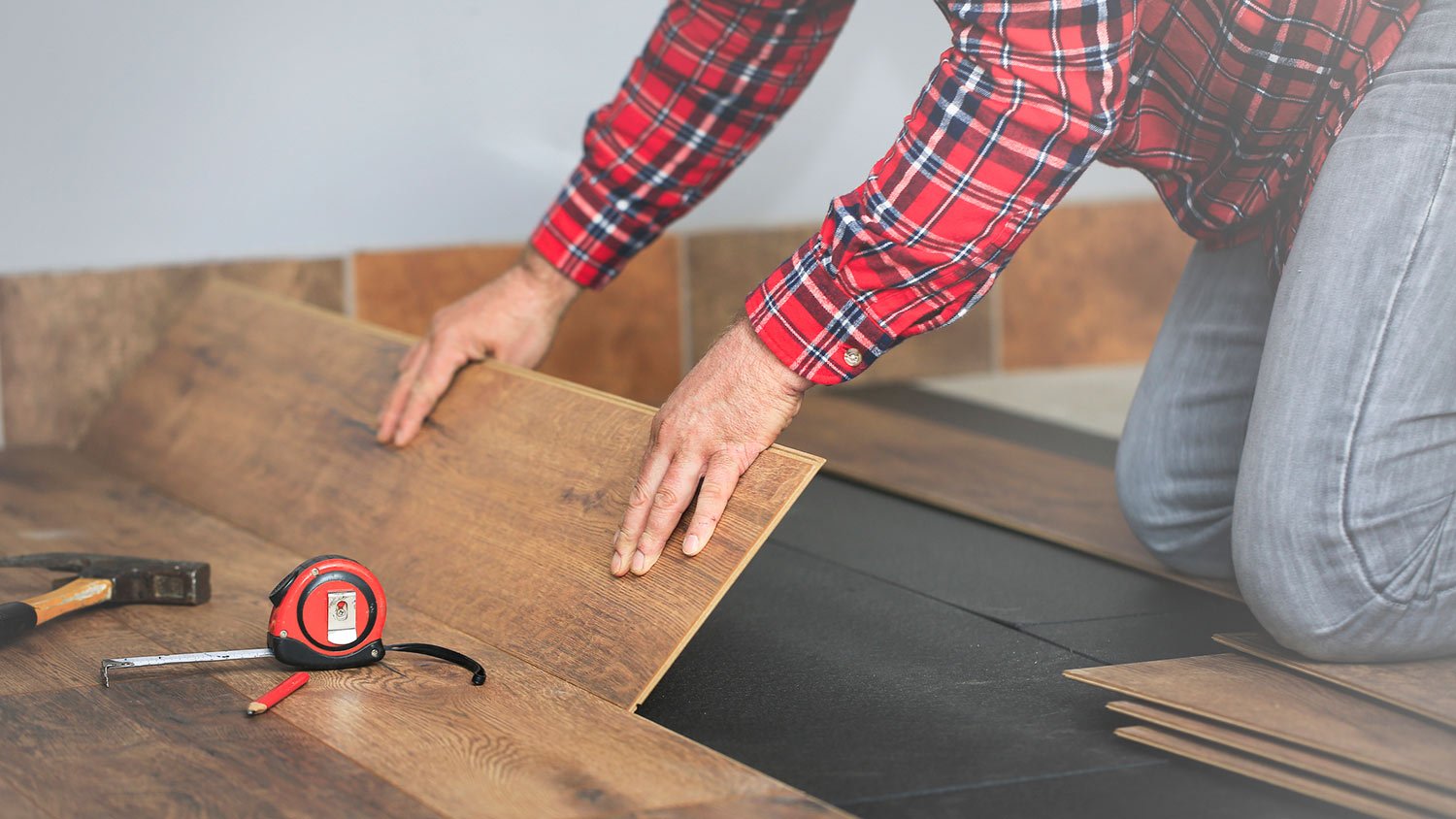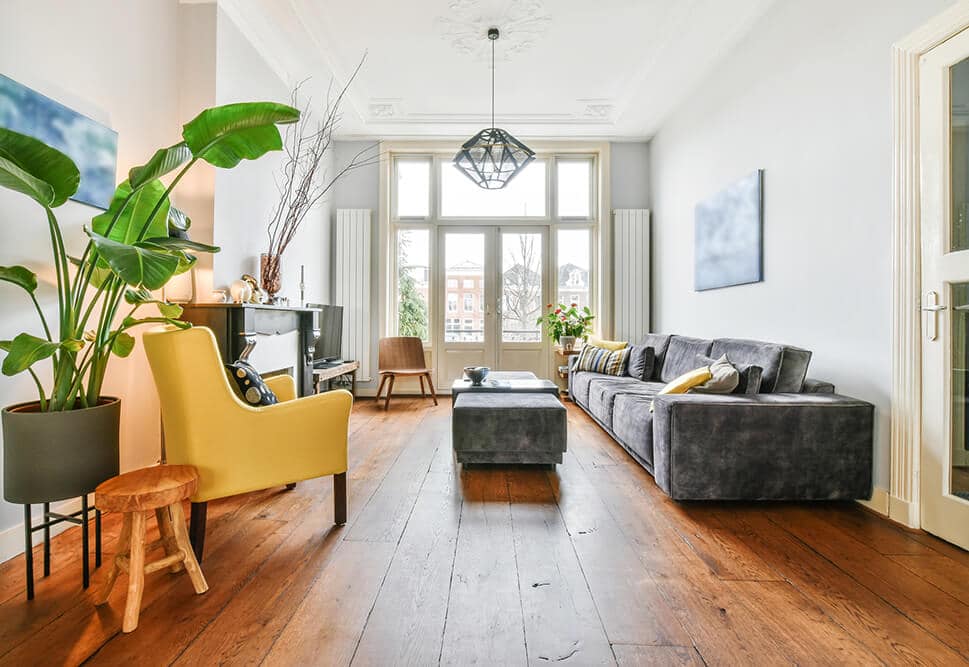4 Wood Floors Perfect for Your Kitchen
Bring the warmth of wood into the heart of your home


Kitchens have become the center of many homes. No longer simply the room for cooking dinner, many kitchens have merged seamlessly with living and dining areas to become spaces for meals, projects, and socializing. As homeowners spend more time in their kitchens, many are bringing the timeless hardwood and wood-look floors from other rooms with them.
Whether the goal for your next kitchen remodel is to eliminate the separation between rooms or simply to design a durable, stylish space to match your lifestyle, here are some great kitchen wood flooring options to choose from.
1. Solid Hardwood Flooring
When you think of hardwood floors, you probably think of traditional solid wood planks, each made from a single piece of natural wood. These floors are usually nailed or stapled directly to a wooden subfloor. Using reclaimed wood recycled from old homes is particularly popular in current kitchen design.
Hardwood planks can be made from a wide variety of tree species that vary in color, pattern, and hardness. Some finishes tend to be slippery, which can be dangerous in a kitchen where household spills are most likely to occur. To provide traction, create texture with a distressed or hand-scraped wood finish or choose a long, wide plank for extra surface area.
Pros of Solid Hardwood in the Kitchen
Durable and able to resist water when pre-finished or treated with the proper finish
Increases your home’s resale value with a timeless look
Will last you a lifetime if properly cared for
The stain color and finish can be changed multiple times if you choose to remodel
Cons of Solid Hardwood in the Kitchen
Long-term exposure to water can cause damage, so spills must be cleaned immediately
Can easily be dented or scratched by dropped pots, pans, or knives
More expensive to install and not DIY-friendly
Tend to expand and shrink with seasonal changes in humidity
2. Engineered Wood
Made by bonding several layers of natural hardwood together, engineered hardwood is designed to be more stable and versatile than traditional solid hardwood. This layered construction enhances its ability to withstand changes in humidity, giving engineered wood a particular advantage in kitchens with a concrete slab subfloor.
Planks are typically a half-inch thick in total, with individual layers of only a few millimeters. They almost always come pre-finished. This can be convenient during installation, but the lack of customization can make it harder to match your existing cabinets and other decor. As with solid hardwood, you’ll need to clean up spills as soon as they happen to avoid water damage.
Pros of Engineered Wood in the Kitchen
Can be stapled, glued, or floated over your subfloor for greater installation flexibility
Won’t soak up surface spills from sinks or cooking as quickly as solid hardwood planks
Won’t warp as quickly as solid hardwood planks when exposed to changes in humidity
Utilizes less milled lumber in its construction for a more environmentally friendly product
Cons of Engineered Wood in the Kitchen
The top layer is thin and usually can’t be sanded or refinished as often as solid wood, meaning you cannot change the color or texture of the planks over time
Water-resistant, but not completely waterproof
3. Laminate Flooring

While technically not hardwood, many laminate floors are made from wood-based composites and offer the look and feel of traditional and modern hardwood styles built into each plank. Like pre-finished hardwood, the look of laminate cannot be altered over time. However, popular wood trends like rustic, hand-scraped finish and reclaimed looks are available in laminate form.
Laminate is also water-resistant, especially when installed as a click-and-lock floating floor. However, the ideal laminate surface for kitchens is waterproof laminate, a relatively new innovation among flooring brands. The strong, stable rigid core of these products is made of a waterproof material that can handle more exposure to moisture than traditional laminate.
Pros of Laminate Floors in the Kitchen
Typically less expensive than natural and engineered hardwood flooring
Flexible installation options including click-look, glue, and floating
Can be floated over uneven subfloors to save time and make repairs easier
Cons of Laminate Floors in the Kitchen
Cannot be refinished if damaged or worn
Many products are only water-resistant, though some are completely waterproof
4. Bamboo Floors
When shopping for bamboo floors, be aware that not all types are ideal for kitchens. Strand woven bamboo is dense and durable—even more so than hardwood—while engineered bamboo actually features a waterproof coating. Solid bamboo, however, is more susceptible to moisture damage and should be avoided when it comes to kitchen installations.
Pros of Bamboo Floors in the Kitchen
Gaining popularity as a harder and denser material than traditional solid hardwood
Most types are resistant to moisture and water damage
Like solid hardwood, can be refinished with a custom color and grain pattern
Eco-friendly; grown with little water, fertilizer, or pesticide, and harvested sustainably
Cons of Bamboo Floors in the Kitchen
Tends not to be as affordable as other wood and wood-look flooring options
Lacks natural grain direction, making refinishing tricky without experienced professionals
Popular Wood Looks for the Kitchen

In addition to the type of flooring you choose, you’ll need to choose the look and texture of the floor. Explore some styles catching on in kitchens today, whether for their unique visual charm or their ability to stand up to the wear and tear in front of the sinks and stoves of high-traffic kitchens. Each of these can be applied to any of the wood flooring types above.
Oak Hardwood
Oak floors rang in tone from white sapwood to dark brown. This species is strong with a pronounced tight, straight grain pattern that hides dirt and dents better than woods with subtle grains. White oak in particular does a great job of hiding wear and tear from foot traffic and common kitchen mishaps like spills, stains, or dropped pots and pans.
Wire-Brushed Finish
The rustic farmhouse kitchen has exploded in popularity for its simple, clean looks and charming worn-in visual style. At the base of many farmhouse designs is a distressed wood floor. The wire-brushed look is characterized by open grains and a two-toned appearance. The movement and texture of this effect hide denting and scratching well.
Light, Natural Wood Colors
Lighter tones in a kitchen tend to help it feel cleaner and brighter for a more open, modern look. Whether you choose a natural hardwood, laminate plank, or bamboo floor, look for lighter color trends from blonde and honey to gray or whitewashed. Also popular is a mix of these light or medium tones with darker, more traditional tones for an eye-catching variety.
Patterned Installations
Parquet flooring is a classic example of this technique. Like tile, you can lay out your hardwood planks in a variety of interesting patterns. Herringbone and diagonal installations are one option, but homeowners are also mixing wide and narrow planks in staggered patterns. These looks are becoming popular throughout the home, making a continuous floor from living areas into your kitchen a timeless investment.
Satin-Sheen Finish
A shiny, high-gloss floor tends to bounce natural light around the room, but it also makes dirt and food particles much more noticeable. A low-gloss, satin sheen can help you hide footprints, scratches, and other high-traffic kitchen wear.
Square-Edged Planks
The edge of each interlocking plank in a wood floor can affect the floor’s look, feel, and performance. A square edge provides a smooth, tight, and nearly undetectable seam between each plank, which blocks out food, dirt, and other debris and makes your kitchen floors much easier to clean.





- The Differences Between Laminate and Hardwood Flooring, Explained
- Engineered Wood Flooring vs. Laminate: Yes, There’s a Difference
- What’s the Best Flooring for Kitchens? Explore 10 Top Picks
- How to Choose Hardwood Flooring in 7 Simple Steps
- The Complete Glossary of Flooring Terms You Need to Know
- How Long Do Hardwood Floors Last and How to Extend Their Life Span
- 5 Things You Should Know Before Selecting Hardwood Floors
- How Often Should You Refinish Hardwood Floors?
- How to Make Your Wood Floors Look Brand New Again
- Bamboo Flooring vs. Hardwood Flooring: Which One Is Right for Your Living Space?











